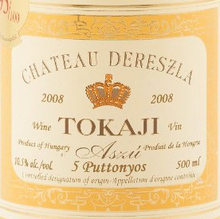What is it?
One of the oldest styles of dessert wine in the world! References of this style date back to the mid 1500s.
Okay – this one demands a bit of attention in order to get all these terms in order.
Tokaji Aszu – Tokaji is the region in northeastern Hungary where this wine originates. Aszu refers to the fact that the grapes for this wine have been shriveled on the vine and have been affected by a special mold called botrytis cinerea.
Here is a picture of a bunch of grapes affected by botrytis cinerea. Yummmm.

This condition can only happen in very specific wine regions around the world. The vineyards must be close to water so that the grapes are dewy in the morning so the airborne mold can attach itself to the fruit.
5 puttonyos. – A puttonyos is a unit of measure that denotes the level of sugar in a Tokaji Aszu wine.
5 puttonyos = 120 grams per litre of sugar.
Who makes it?
Chateau Dereszla has a history dating back to the 1400s in the time of the kings and courts of Hungary. Political turmoil in the region has seen this estate in many different hands including being nationalized after WWII. A French estate purchased it in 2000 and has started a complete focus on quality.
Where does it come from?
Tokaji (pronoucned Tow-kaii) is a region in north east Hungary. The land is a UNESCO world heritage site.
What does it taste like?
Botrytis cinerea contributes a very unique and specific flavour and aroma to a wine. This is described as dried apricot, dried mango, dried pineapple with a hint of fungal, truffle-y nuance. The fruit flavour certainly spans that tropical and exotic realm. Meanwhile, the palate is full and unctuous sharing textures of honey. But! Really importantly! ...there is a seam of sensational acidity that balances the sweetness to create a truly moving luxurious dessert wine.
Is it a classic?
One of the most classic of the wine world.
What should I eat with it?
Classically, this style is sipped alongside pates, foie gras, blue cheese, and richer desserts. For us – it’s foie gras all the way. This should be very high on your repertoire of exciting pairings to share with your guests.
Sommelier says:
“In formal wine education, one of the very first wine and food matches that you learn about is the harmony between botrytized wines and either blue cheese or foie gras. It marks you for life – it makes you say ‘whoaaaa, okay I get it.’ Here, with this wine, we have the opportunity to do this for all of our guests. The sweetness of this style absolutely enrobes the richness of these ingredients and the acidity offers a bright refreshment. And it’s from Hungary!” ~JY
